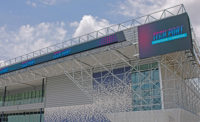American Family Insurance Amphitheater
Milwaukee
BEST PROJECT
Submitted By: Hunzinger Construction Co.
Owner: Milwaukee World Festival Inc.
Lead Designer: EUA
General Contractor: Hunzinger Construction Co.
Structural Engineer: Larson Engineering Inc.
Civil Engineering: The Sigma Group
Plumbing Contractor (MEP Design/Builder): Mid City Plumbing & Heating
Electrical Contracting (MEP Design/Builder): Staff Electric Co.
Hunzinger Construction’s performance on the American Family Insurance Amphitheater project literally raised the roof. The team devised a way to safely and expeditiously raise a half-acre roof over the amphitheater stage, enabling the venue to book larger productions.
Completed in May 2021, the 33-month project was split into two phases. The first phase raised the massive roof from 39 ft above grade to 65 ft. The portion raised was 24,100 sq ft and weighed 607,000 lb. For the second phase, the “back of house” building was rebuilt, including 19 new dressing rooms and showers, 23 new restrooms and six new loading docks.
To raise the roof, the team extended the existing columns. With the columns at full height, the roof could then be lifted from above. Eight strand jacks utilized the permanent structural system to execute the lift.
“We didn’t have to build falsework below to lift it,” says Joel Becker, vice president of field operations at Hunzinger Construction. “So there was no need for a lot of extraneous work that was not part of the end-product.”

Photo courtesy of Mike Warnecke
Weekly meetings were held between Hunzinger, the lift contractor, the steel fabricator and engineers to review and coordinate the lift.
The lift beams and equipment were fabricated and loaded into containers in Spain for shipping to Milwaukee. The containers reached the project site in early 2019. By then, the support steel was erected and the temporary steel and lifting lugs installed. Simultaneously, the stage that had been demolished was being reconstructed.
A 300-ft boom crane was used to install the lift beams and jacks. Once installed and interconnected at the control room, the strand jacks were loaded to 90% of the anticipated load. After the jacks were loaded to the anticipated weight, the roof trusses and purlins were cut loose. The stroke of the hydraulic jacks was 18 in., allowing for length adjustments between strokes to ensure a uniform lift. The weight of the roof portions at each jack needed to be calculated to ensure uniform lifting. Each strand jack’s capacity varies from 95 tons to 201 tons, depending on the location. The lift proceeded for about five hours to reach the 26-ft level.
“We lifted this in hours and not days,” Becker says. “The other approaches we looked at required supporting [the roof] for days, trying to make the connections.”

Photo courtesy of Mike Warnecke
Reattachment of the trusses to the new upper frame began the following morning. The main trusses and lift jacks were at eight locations. Eight welders in manlifts were used at each location to reattach the roof. Eight weld inspectors were on site to verify, preheat, observe and test welds.
The lift was also completed in the winter along Lake Michigan, which can produce strong winds. “We’re on the lake so you had wind loading to consider and temperatures to consider,” Becker adds. “You know when you’re working on water like that the winds could come up quickly.”
Becker notes that the technique was also safer than traditional methods. The entire project had a perfect safety record with no OSHA recordable incidents and no lost-time accidents over 450,000 worker-hours.




